Jan Held
SoccerNet 2025 Challenges Results
Aug 26, 2025Abstract:The SoccerNet 2025 Challenges mark the fifth annual edition of the SoccerNet open benchmarking effort, dedicated to advancing computer vision research in football video understanding. This year's challenges span four vision-based tasks: (1) Team Ball Action Spotting, focused on detecting ball-related actions in football broadcasts and assigning actions to teams; (2) Monocular Depth Estimation, targeting the recovery of scene geometry from single-camera broadcast clips through relative depth estimation for each pixel; (3) Multi-View Foul Recognition, requiring the analysis of multiple synchronized camera views to classify fouls and their severity; and (4) Game State Reconstruction, aimed at localizing and identifying all players from a broadcast video to reconstruct the game state on a 2D top-view of the field. Across all tasks, participants were provided with large-scale annotated datasets, unified evaluation protocols, and strong baselines as starting points. This report presents the results of each challenge, highlights the top-performing solutions, and provides insights into the progress made by the community. The SoccerNet Challenges continue to serve as a driving force for reproducible, open research at the intersection of computer vision, artificial intelligence, and sports. Detailed information about the tasks, challenges, and leaderboards can be found at https://www.soccer-net.org, with baselines and development kits available at https://github.com/SoccerNet.
Triangle Splatting for Real-Time Radiance Field Rendering
May 25, 2025



Abstract:The field of computer graphics was revolutionized by models such as Neural Radiance Fields and 3D Gaussian Splatting, displacing triangles as the dominant representation for photogrammetry. In this paper, we argue for a triangle comeback. We develop a differentiable renderer that directly optimizes triangles via end-to-end gradients. We achieve this by rendering each triangle as differentiable splats, combining the efficiency of triangles with the adaptive density of representations based on independent primitives. Compared to popular 2D and 3D Gaussian Splatting methods, our approach achieves higher visual fidelity, faster convergence, and increased rendering throughput. On the Mip-NeRF360 dataset, our method outperforms concurrent non-volumetric primitives in visual fidelity and achieves higher perceptual quality than the state-of-the-art Zip-NeRF on indoor scenes. Triangles are simple, compatible with standard graphics stacks and GPU hardware, and highly efficient: for the \textit{Garden} scene, we achieve over 2,400 FPS at 1280x720 resolution using an off-the-shelf mesh renderer. These results highlight the efficiency and effectiveness of triangle-based representations for high-quality novel view synthesis. Triangles bring us closer to mesh-based optimization by combining classical computer graphics with modern differentiable rendering frameworks. The project page is https://trianglesplatting.github.io/
3D Convex Splatting: Radiance Field Rendering with 3D Smooth Convexes
Nov 26, 2024

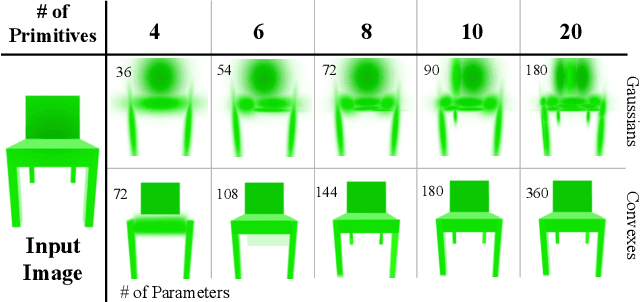

Abstract:Recent advances in radiance field reconstruction, such as 3D Gaussian Splatting (3DGS), have achieved high-quality novel view synthesis and fast rendering by representing scenes with compositions of Gaussian primitives. However, 3D Gaussians present several limitations for scene reconstruction. Accurately capturing hard edges is challenging without significantly increasing the number of Gaussians, creating a large memory footprint. Moreover, they struggle to represent flat surfaces, as they are diffused in space. Without hand-crafted regularizers, they tend to disperse irregularly around the actual surface. To circumvent these issues, we introduce a novel method, named 3D Convex Splatting (3DCS), which leverages 3D smooth convexes as primitives for modeling geometrically-meaningful radiance fields from multi-view images. Smooth convex shapes offer greater flexibility than Gaussians, allowing for a better representation of 3D scenes with hard edges and dense volumes using fewer primitives. Powered by our efficient CUDA-based rasterizer, 3DCS achieves superior performance over 3DGS on benchmarks such as Mip-NeRF360, Tanks and Temples, and Deep Blending. Specifically, our method attains an improvement of up to 0.81 in PSNR and 0.026 in LPIPS compared to 3DGS while maintaining high rendering speeds and reducing the number of required primitives. Our results highlight the potential of 3D Convex Splatting to become the new standard for high-quality scene reconstruction and novel view synthesis. Project page: convexsplatting.github.io.
Physically Interpretable Probabilistic Domain Characterization
Nov 22, 2024Abstract:Characterizing domains is essential for models analyzing dynamic environments, as it allows them to adapt to evolving conditions or to hand the task over to backup systems when facing conditions outside their operational domain. Existing solutions typically characterize a domain by solving a regression or classification problem, which limits their applicability as they only provide a limited summarized description of the domain. In this paper, we present a novel approach to domain characterization by characterizing domains as probability distributions. Particularly, we develop a method to predict the likelihood of different weather conditions from images captured by vehicle-mounted cameras by estimating distributions of physical parameters using normalizing flows. To validate our proposed approach, we conduct experiments within the context of autonomous vehicles, focusing on predicting the distribution of weather parameters to characterize the operational domain. This domain is characterized by physical parameters (absolute characterization) and arbitrarily predefined domains (relative characterization). Finally, we evaluate whether a system can safely operate in a target domain by comparing it to multiple source domains where safety has already been established. This approach holds significant potential, as accurate weather prediction and effective domain adaptation are crucial for autonomous systems to adjust to dynamic environmental conditions.
SoccerNet 2024 Challenges Results
Sep 16, 2024
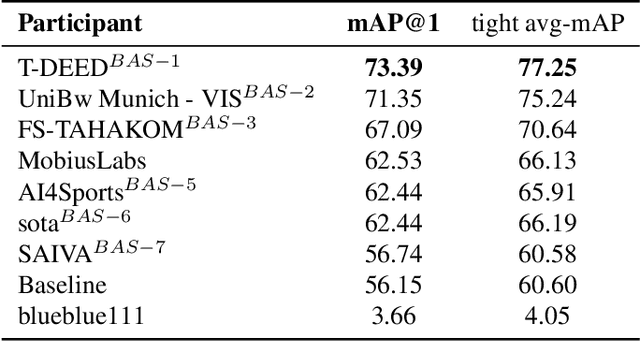
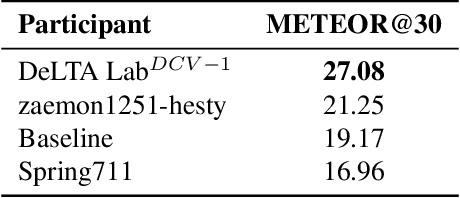
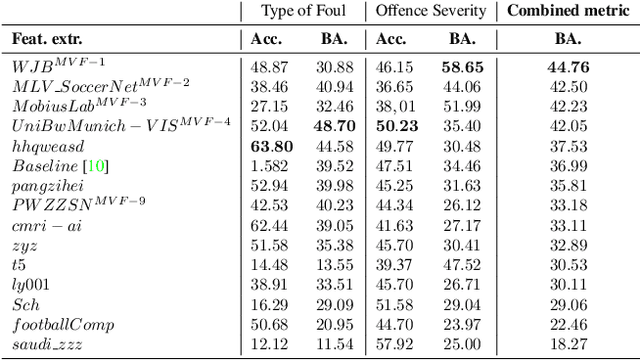
Abstract:The SoccerNet 2024 challenges represent the fourth annual video understanding challenges organized by the SoccerNet team. These challenges aim to advance research across multiple themes in football, including broadcast video understanding, field understanding, and player understanding. This year, the challenges encompass four vision-based tasks. (1) Ball Action Spotting, focusing on precisely localizing when and which soccer actions related to the ball occur, (2) Dense Video Captioning, focusing on describing the broadcast with natural language and anchored timestamps, (3) Multi-View Foul Recognition, a novel task focusing on analyzing multiple viewpoints of a potential foul incident to classify whether a foul occurred and assess its severity, (4) Game State Reconstruction, another novel task focusing on reconstructing the game state from broadcast videos onto a 2D top-view map of the field. Detailed information about the tasks, challenges, and leaderboards can be found at https://www.soccer-net.org, with baselines and development kits available at https://github.com/SoccerNet.
Towards AI-Powered Video Assistant Referee System (VARS) for Association Football
Jul 18, 2024Abstract:Over the past decade, the technology used by referees in football has improved substantially, enhancing the fairness and accuracy of decisions. This progress has culminated in the implementation of the Video Assistant Referee (VAR), an innovation that enables backstage referees to review incidents on the pitch from multiple points of view. However, the VAR is currently limited to professional leagues due to its expensive infrastructure and the lack of referees worldwide. In this paper, we present the semi-automated Video Assistant Referee System (VARS) that leverages the latest findings in multi-view video analysis. VARS sets a new state-of-the-art on the SoccerNet-MVFoul dataset, a multi-view video dataset of football fouls. Our VARS achieves a new state-of-the-art on the SoccerNet-MVFoul dataset by recognizing the type of foul in 50% of instances and the appropriate sanction in 46% of cases. Finally, we conducted a comparative study to investigate human performance in classifying fouls and their corresponding severity and compared these findings to our VARS. The results of our study highlight the potential of our VARS to reach human performance and support football refereeing across all levels of professional and amateur federations.
SoccerNet-Echoes: A Soccer Game Audio Commentary Dataset
May 12, 2024


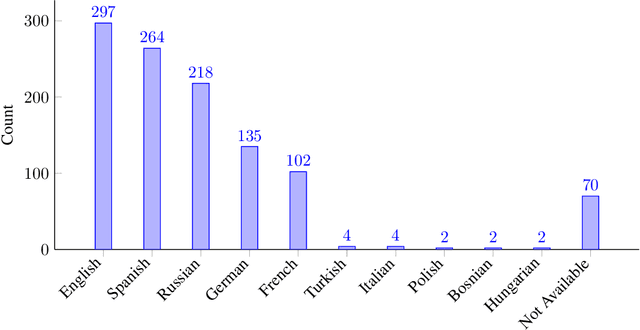
Abstract:The application of Automatic Speech Recognition (ASR) technology in soccer offers numerous opportunities for sports analytics. Specifically, extracting audio commentaries with ASR provides valuable insights into the events of the game, and opens the door to several downstream applications such as automatic highlight generation. This paper presents SoccerNet-Echoes, an augmentation of the SoccerNet dataset with automatically generated transcriptions of audio commentaries from soccer game broadcasts, enhancing video content with rich layers of textual information derived from the game audio using ASR. These textual commentaries, generated using the Whisper model and translated with Google Translate, extend the usefulness of the SoccerNet dataset in diverse applications such as enhanced action spotting, automatic caption generation, and game summarization. By incorporating textual data alongside visual and auditory content, SoccerNet-Echoes aims to serve as a comprehensive resource for the development of algorithms specialized in capturing the dynamics of soccer games. We detail the methods involved in the curation of this dataset and the integration of ASR. We also highlight the implications of a multimodal approach in sports analytics, and how the enriched dataset can support diverse applications, thus broadening the scope of research and development in the field of sports analytics.
X-VARS: Introducing Explainability in Football Refereeing with Multi-Modal Large Language Model
Apr 07, 2024Abstract:The rapid advancement of artificial intelligence has led to significant improvements in automated decision-making. However, the increased performance of models often comes at the cost of explainability and transparency of their decision-making processes. In this paper, we investigate the capabilities of large language models to explain decisions, using football refereeing as a testing ground, given its decision complexity and subjectivity. We introduce the Explainable Video Assistant Referee System, X-VARS, a multi-modal large language model designed for understanding football videos from the point of view of a referee. X-VARS can perform a multitude of tasks, including video description, question answering, action recognition, and conducting meaningful conversations based on video content and in accordance with the Laws of the Game for football referees. We validate X-VARS on our novel dataset, SoccerNet-XFoul, which consists of more than 22k video-question-answer triplets annotated by over 70 experienced football referees. Our experiments and human study illustrate the impressive capabilities of X-VARS in interpreting complex football clips. Furthermore, we highlight the potential of X-VARS to reach human performance and support football referees in the future.
SoccerNet 2023 Challenges Results
Sep 12, 2023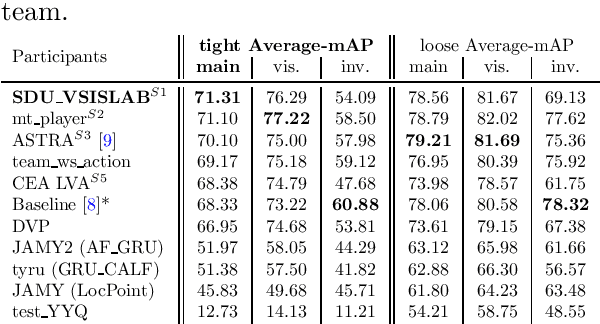


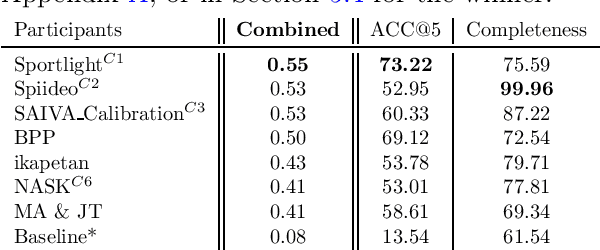
Abstract:The SoccerNet 2023 challenges were the third annual video understanding challenges organized by the SoccerNet team. For this third edition, the challenges were composed of seven vision-based tasks split into three main themes. The first theme, broadcast video understanding, is composed of three high-level tasks related to describing events occurring in the video broadcasts: (1) action spotting, focusing on retrieving all timestamps related to global actions in soccer, (2) ball action spotting, focusing on retrieving all timestamps related to the soccer ball change of state, and (3) dense video captioning, focusing on describing the broadcast with natural language and anchored timestamps. The second theme, field understanding, relates to the single task of (4) camera calibration, focusing on retrieving the intrinsic and extrinsic camera parameters from images. The third and last theme, player understanding, is composed of three low-level tasks related to extracting information about the players: (5) re-identification, focusing on retrieving the same players across multiple views, (6) multiple object tracking, focusing on tracking players and the ball through unedited video streams, and (7) jersey number recognition, focusing on recognizing the jersey number of players from tracklets. Compared to the previous editions of the SoccerNet challenges, tasks (2-3-7) are novel, including new annotations and data, task (4) was enhanced with more data and annotations, and task (6) now focuses on end-to-end approaches. More information on the tasks, challenges, and leaderboards are available on https://www.soccer-net.org. Baselines and development kits can be found on https://github.com/SoccerNet.
VARS: Video Assistant Referee System for Automated Soccer Decision Making from Multiple Views
Apr 10, 2023Abstract:The Video Assistant Referee (VAR) has revolutionized association football, enabling referees to review incidents on the pitch, make informed decisions, and ensure fairness. However, due to the lack of referees in many countries and the high cost of the VAR infrastructure, only professional leagues can benefit from it. In this paper, we propose a Video Assistant Referee System (VARS) that can automate soccer decision-making. VARS leverages the latest findings in multi-view video analysis, to provide real-time feedback to the referee, and help them make informed decisions that can impact the outcome of a game. To validate VARS, we introduce SoccerNet-MVFoul, a novel video dataset of soccer fouls from multiple camera views, annotated with extensive foul descriptions by a professional soccer referee, and we benchmark our VARS to automatically recognize the characteristics of these fouls. We believe that VARS has the potential to revolutionize soccer refereeing and take the game to new heights of fairness and accuracy across all levels of professional and amateur federations.
 Add to Chrome
Add to Chrome Add to Firefox
Add to Firefox Add to Edge
Add to Edge